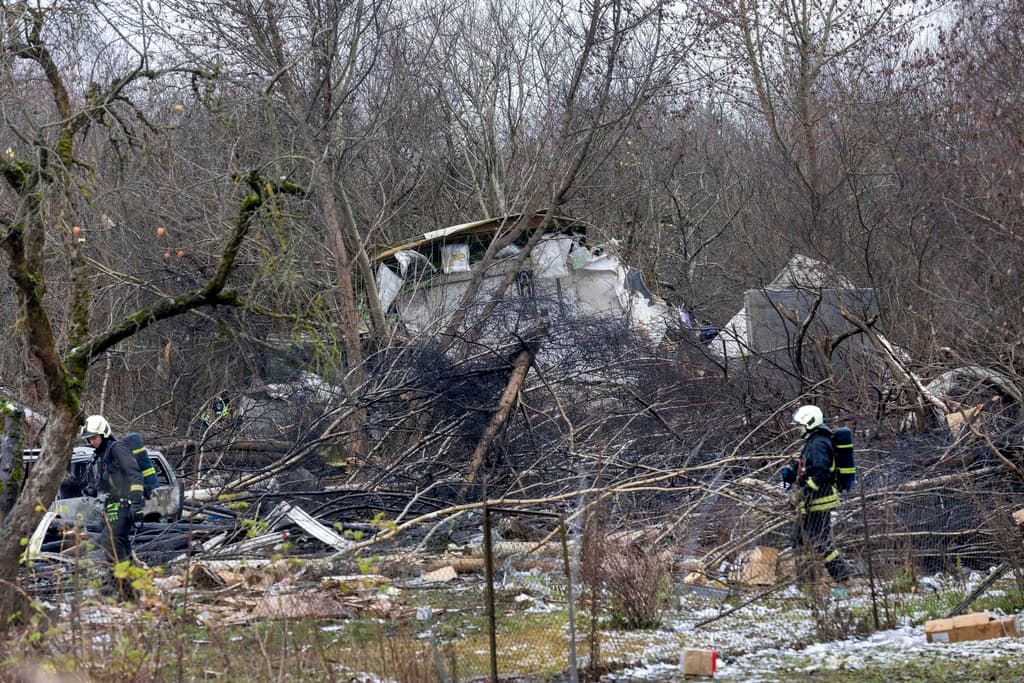Baltic States Bridle as Russia Is Suspected of Being Behind Months of Mischief in the Region
Russia is jamming GPS signals, analysts believe, along what used to be known as a ‘Soviet sea’ and that is emerging as a ‘NATO lake.’

Pushing back against the Baltic Sea’s emergence as a “NATO lake” after it was long known as a “Soviet sea,” Russia is jamming GPS signals. This in theory could have affected a DHL cargo flight that crashed in pre-dawn darkness Monday about half a mile short of its destination, the international airport of Vilnius in Lithuania, a former Soviet republic, analysts say. And someone is cutting undersea cables.
In Soviet days, Moscow controlled half of the Baltic shortline, from East Germany to St. Petersburg. The other half, in the hands of Finland and Sweden, was neutral. Today, seven NATO countries account for most of the shoreline. Russia controls only two small sections, the exclave of Kaliningrad and the area around St. Petersburg.
For the last year, Russian GPS jamming out of Kaliningrad and St. Petersburg has affected commercial aviation in areas around the Baltic. Lacking reliable navigation, pilots have aborted several flights from Finland.
“DHL/Swift flight BCS18D was jammed from Kaliningrad on its final 34 minutes before crashing into a house in Vilnius,” an open-source transportation blogger, Auonsson, writes on Bluesky. “So were at least 6-20 other aircraft in the area at that time.”
Last summer, incendiary devices ignited at DHL logistics hubs, one at Leipzig, eastern Germany, and another at Birmingham, England. Earlier this month, the Wall Street Journal cited security officials as saying the devices had been shipped from Vilnius and were part of a covert Russian operation to start fires aboard cargo or passenger aircraft flying to North America.
“With all we have and all we know, there are no signs that it could have been an act of sabotage,” the Lithuanian defense minister, Laurynas Kasciunas, told reporters Wednesday at Vilnius in respect of the crash that killed one crew member. The three surviving crew members said there had been no chaos or concern inside the aircraft preceding the crash, and no smoke or smell, the minister said, according to Reuters.
Investigators from DHL and Boeing have joined a U.S. National Transportation Safety Board team to help Lithuania with its probe of the flight, which originated at Leipzig. A DHL spokesman, Dirk Heinrichs, on Wednesday sent the Sun this comment via email: “The cause of the accident is still unknown and an investigation is already underway.” Officials from the scene said the cargo aircraft did not use GPS for landing, and any interference with such signals was unlikely to have had an impact.
Six-hundred miles to the east, as many as five Danish and German warships on Wednesday were guarding a Chinese bulk carrier, the Yi Peng 3, which Danish and Swedish investigators suspect dragged its anchor on the night of November 17, cutting two trans-Baltic undersea cables. The anchor dragging went on for six hours as the ship moved across 111 miles of waters in Sweden’s exclusive economic zone. During that time, the ship turned off its automatic identification system signal.
With a Chinese captain, the boat is believed to have picked up a Russian passenger when it took on a load of fertilizer at the Russian Baltic port of Ust-Luga on November 15. Danish navy ships detained the Chinese ship as it was passing through Danish straits, at the western exit of the Baltic.
“If you sail 400 km through the Baltic Sea with the anchor lowered to destroy international internet cables, you do not leave the Baltic Sea unscathed,” a Danish parliamentarian, Rasmus Jarlov, wrote Wednesday on Bluesky. As chairman of the parliament’s defense committee, he wrote: “Now that’s enough. This kind of thing must be answered proportionately. The damage they cause us must be retaliated against.”
Separately, he told Denmark’s Jyllands-Posten newspaper: “If there are mysterious incidents where internet cables are snapped in Western waters, there can also be mysterious incidents where cables are snapped in Chinese waters.”
In Stockholm, Prime Minister Kristersson told reporters Tuesday: “From the Swedish side we have had contact with the ship and contact with China and said that we want the ship to move towards Swedish waters.” He added: “This is the second time in a relatively short period of time that there have been serious physical cable breaches.”
One year ago, Western navies allowed a Chinese ship to leave the Baltic for the Arctic after it was believed to have dragged an anchor, cutting internet cables and damaging a gas pipeline between Finland and Estonia. An investigation determined that that ship, the Newnew Polar Bear, did indeed cause the damage. It was not determined if it was an accident or a malicious act.
Over the last year, Scandinavian prosecutors have prepared legal grounds to take action in the event of a repeat. Drawing on the 1884 Convention for the Protection of Submarine Telegraph Cables, Sweden now is asking the Yi Peng 3’s captain to return the ship to Swedish waters and to prepare for boarding.
The incidents come as Russia appears to be probing the West in other ways that are easy to deny. Over the last week, unidentified drones have buzzed three major United States Air Force bases in England — RAF Lakenheath, RAF Mildenhall, and RAF Feltwell. About 60 American and British personnel have been deployed to discover what is going on, the Times reports. The London newspaper cites a British military source as saying the drones could be part of a “sinister” plot.
Separately, Russia has taken hostile actions against Finland, which joined NATO 18 months ago. In response, Finland has closed all its land border crossings with its eastern neighbor. On Monday, two American B-52H Stratofortresses simulated a “weapons drop” over Finland. Finnish F/A-18C Hornet and Swedish JAS 39 Gripen fighter jets accompanied the bombers, which are configured to drop conventional, non-nuclear weapons.
Striking back against Russia’s new, hybrid style of probing and sabotage, NATO launched in Britain last May the Maritime Center for Security of Critical Undersea Infrastructure.
“If a malefactor is going to try to harass, undermine or clandestinely attack offshore infrastructure, undersea infrastructure, the main thing we seek to achieve is that they cannot get away with it,” the center’s political advisor, James Bergeron, said at the time. “Instead, they will be spotted. The cameras will be snapping. The underwater sensors will be monitoring, and there will be a signals trail of liability, so that they’re not going to be able to deny their actions and will ultimately be held liable.”

